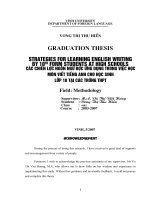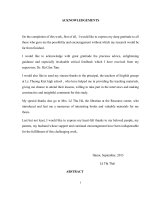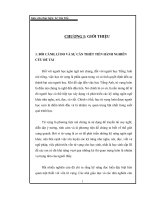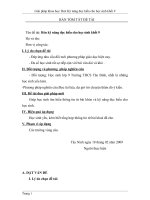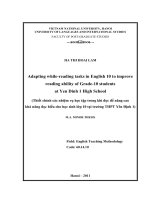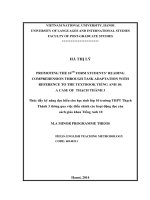Sử dụng chiến lược phán đoán để nâng cao kỹ năng đọc hiểu cho học sinh lớp 10 tại một trường trung học phổ thông
Bạn đang xem bản rút gọn của tài liệu. Xem và tải ngay bản đầy đủ của tài liệu tại đây (1.43 MB, 107 trang )
VIETNAM NATIONAL UNIVERSITY- HA NOI
UNIVERSITY OF LANGUAGES AND INTERNATIONAL STUDIES
FACULTY OF POST GRADUATE STUDIES
BÙI THỊ TÚ ANH
USING PREDICTION STRATEGY TO ENHANCE READING
COMPREHENSION SKILL FOR THE 10TH FORM STUDENTS AT A
HIGH SCHOOL IN NINH BINH PROVINCE
SỬ DỤNG CHIẾN LƯỢC PHÁN ĐOÁN ĐỂ NÂNG CAO KỸ NĂNG ĐỌC
HIỂU CHO HỌC SINH LỚP 10 TẠI MỘT TRƯỜNG TRUNG HỌC PHỔ
THÔNG THUỘC TỈNH NINH BÌNH
M.A. Minor Programme Thesis
Field: English Teaching Methodology
Code: 8140231.01
Hanoi - 2018
VIETNAM NATIONAL UNIVERSITY- HA NOI
UNIVERSITY OF LANGUAGES AND INTERNATIONAL STUDIES
FACULTY OF POST GRADUATE STUDIES
BÙI THỊ TÚ ANH
USING PREDICTION STRATEGY TO ENHANCE READING
COMPREHENSION SKILL FOR THE 10TH FORM STUDENTS AT A
HIGH SCHOOL IN NINH BINH PROVINCE
SỬ DỤNG CHIẾN LƯỢC PHÁN ĐOÁN ĐỂ NÂNG CAO KỸ NĂNG ĐỌC
HIỂU CHO HỌC SINH LỚP 10 TẠI MỘT TRƯỜNG TRUNG HỌC PHỔ
THÔNG THUỘC TỈNH NINH BÌNH
M.A. Minor Programme Thesis
Field: English Teaching Methodology
Code: 8140231.01
Supervisor: Dr. Mai Thị Loan
Hanoi - 2018
DECLARATION
I, Bùi Thị Tú Anh, hereby certify that the thesis entitled “Using prediction strategy
to enhance reading comprehension skill for the 10th form students at a high school
in Ninh Binh province.” is submitted for the partial fulfillment of the Degree of
Master of Arts at the Faculty of Post-Graduate Studies, University of Languages
and International Studies, Vietnam National University, Hanoi. I also declare that
this thesis is the result of my own research and efforts and it has not been submitted
for any other purposes.
Hanoi, 2018
Bùi Thị Tú Anh
i
ACKNOWLEGEMENTS
First and foremost, I would like to express my heart - felt thank and my
sincere gratitude to my supervisor Dr Mai Thi Loan for her enlightening guidance,
precious suggestions and invaluable encouragement during my fulfillment of this
minor thesis.
My sincere thanks go to all of the lecturers and the staff of the Faculty of
Post Graduate Studies at University of Languages and International Studies for their
valuable lectures on which my minor thesis was laid the foundation.
I truly wish to thank all the students of class 10A and 10B at Nho Quan C
High School who have actively participated in the research.
I am deeply grateful to my family for their great support and to many of my
friends for their notable assistance.
ii
ABSTRACT
This research is an investigation into the predominant problems in learning
reading at a high school in Ninh Binh province and the implementation a of new
reading strategy, which is prediction strategy in this case to deal with the situation.
The primary purpose of the study is an attempt to examine the impact of using
prediction strategy on the improvement of reading comprehension skill of the 10th
form students and find out effective ways to implement prediction strategy in
reading comprehension lessons. Data were collected through pretest, posttest,
questionnaire and teaching diaries and then analyzed quantitatively and
qualitatively. The results of the data analysis indicate that most of the students
achieved considerable progress in their reading comprehension skill after being
taught prediction strategy. The students also participated in the lesson more and
more actively and excitedly. In addition, the findings of the research suggested
some effective ways to teach students to use prediction strategy in reading
comprehension lessons such as conducting the lesson with three stages (pre-, while
and post reading), choosing well-suited reading materials, enlarging students‟
schema for further reading, instructing the strategy clearly, combining prediction
strategy with other reading strategies, designing useful and exciting tasks, and
letting students work in pairs or groups.
iii
TABLE OF CONTENTS
DECLARATION ........................................................................................................ i
ACKNOWLEGEMENTS .......................................................................................... ii
ABSTRACT .............................................................................................................. iii
TABLE OF CONTENTS .......................................................................................... iv
LIST OF ABBREVIATIONS ................................................................................. viii
LISTS OF TABLES AND FIGURES ...................................................................... ix
PART A: INTRODUCTION ......................................................................................1
1. Rationale .............................................................................................................1
2. Aims and objectives of the study ........................................................................2
3. Research question ...............................................................................................3
4. Scope of the study ...............................................................................................3
5. Significance of the study ....................................................................................3
6. Design of the study .............................................................................................3
PART B: DEVELOPMENT .......................................................................................5
CHAPTER 1: LITERATURE REVIEW ....................................................................5
1.1 The nature of reading comprehension ...................................................................5
1.1.1 Definitions of reading ....................................................................................5
1.1.2 Definitions of reading comprehension...........................................................6
1.1.3 Reading models..............................................................................................7
1.1.4 Schema theory................................................................................................9
1.2 Reading strategies ...............................................................................................10
1.2.1 Definitions of reading strategies ..................................................................10
1.2.2 Classifications of reading strategies ............................................................11
1.2.3 Reading strategy instruction ........................................................................13
1.3 Prediction strategy ...............................................................................................14
1.3.1 Definitions of prediction strategy ................................................................14
1.3.2 The importance of prediction strategy .........................................................14
1.3.3 Application of prediction strategy in reading comprehension lesson .........15
iv
1.4 Previous studies on the use of prediction strategy ..............................................18
1.5 Summary .............................................................................................................20
CHAPTER II: METHODOLOGY ............................................................................21
2.1 Context of the study ............................................................................................21
2.1.1 Setting of the study ......................................................................................21
2.1.2 Participants...................................................................................................22
2.1.3 Materials ......................................................................................................22
2.2 Research design ...................................................................................................22
2.2.1 Research approach .......................................................................................22
2.2.2 Research procedures ....................................................................................23
2.3 Data collection instruments .................................................................................28
2.3.1 Pretest and posttest.......................................................................................29
2.3.2 Questionnaire ...............................................................................................29
2.3.3 Teaching diaries ...........................................................................................30
2.4 Data analysis methods .........................................................................................31
2.5 Summary .............................................................................................................31
CHAPTER 3: DATA ANALYSIS AND FINDINGS ..............................................32
3.1 Data analysis .......................................................................................................32
3.1.1 Analysis of test results .................................................................................32
3.1.1.1 Results of the pretest ............................................................................32
3.1.1.2 Results of the posttest ...........................................................................34
3.1.2 Analysis of questionnaires ...........................................................................36
3.1.2.1 Students‟ belief about the impact of prediction strategy on their reading
comprehension competence .............................................................................36
3.1.2.2 Students‟ self-evaluation of the improvements of their reading
comprehension skill after attending the reading course implementing
prediction strategy…………………….……………………...………………38
3.1.2.3 Students‟ evaluation of the effectiveness of teacher‟s strategy
instruction ….…………………………...……………………...…………….39
3.1.2.4 Students‟ rating of the familiarity of each reading text before the
treatment……………. ......................................................................................40
v
3.1.2.5 Students‟ preferred practices in the pre-reading stage .........................41
3.1.2.6 Students‟ preferred practices in the while reading stage ......................42
3.1.2.7 Students‟ opinion about the reading tasks ............................................43
3.1.2.8 Some disadvantages of implementing prediction strategy in reading
lessons...............................................................................................................43
3.1.3 Analysis of teaching diaries .........................................................................44
3.2 Findings and discussion ......................................................................................49
3.2.1 To what extent does the use of prediction strategy affect Nho Quan C high
school‟s grade 10 students‟ reading comprehension? ..........................................49
3.2.2 How should prediction strategy be implemented to improve the students‟
reading comprehension skill? ...............................................................................50
3.3 Summary .............................................................................................................53
PART C: CONCLUSION .........................................................................................55
1. Recapitulation ...................................................................................................55
2. Concluding remarks ..........................................................................................56
3. Limitation of the current research .....................................................................56
4. Recommendation and suggestions for future research .....................................57
REFERENCES ..........................................................................................................58
APPENDIX 1: READING COMPREHENSION TEST 1 ......................................... I
APPENDIX 2: READING COMPREHENSION 2 ................................................. IV
APPENDIX 3A: POST-TREATMENT QUESTIONNAIRE ................................ VII
(ENGLISH VERSION) ........................................................................................... VII
APPENDIX 3B: POST-TREATMENT QUESTIONNAIRE ................................... X
(VIETNAMESE VERSION) ..................................................................................... X
APPENDIX 4A: SAMPLE LESSON PLAN FOR THE EXPERIMENTAL
GROUP……………………………………..………………………………….XIV
APPENDIX 4B: SAMPLE LESSON PLAN FOR THE CONTROL GROUP ...... XX
APPENDIX 5: PREDICTION CHART .............................................................XXIV
APPENDIX 6A: CRITERIA FOR TEACHING DIARIES ................................ XXV
APPENDIX 6B: A SAMPLE OF TEACHING DIARY ....................................XXVI
vi
APPENDIX 7: THE FORMULA OF MEAN, STANDARD DEVIATION AND
MEDIAN .............................................................................................................XXIX
vii
LIST OF ABBREVIATIONS
MOET:
the Ministry of Education and Training
%
:
Percentage
N
:
Number
viii
LISTS OF TABLES AND FIGURES
Table 1.1: Classification of reading strategies………………………………...
12
Table 1.2: Activities/ tasks to develop prediction strategy…………………....
18
Table 2.1: The course procedures for the experimental group………………..
25
Table 3.1: Mean and std. Deviation of the pretest results…………………….
33
Table 3.2: Comparison of mean, std deviation, mode, minimum and
maximum between the two groups‟ tests……………………………………...
35
Table 3.3: Students‟ belief about the impact of prediction strategy on reading
comprehension competence…………………………………………………...
37
Table 3.4: Students‟ ratings of the familiarity of each reading topic………….
40
Table 3.5: Students‟ preferred practices in the pre-listening stage……………
41
Table 3.6: Students‟ preferred practices in while reading stage………………
42
Figure 3.1: Pretest results of two classes……………………………………...
32
Figure 3.2: Posttest results of two classes……………………………………..
34
Figure 3.3: Students‟ self-evaluation of their improvement after the
treatment………………………………………………………………….........
38
Figure 3.4: Students‟ evaluation of teacher‟s strategy instruction‟s
effectiveness…………………………………………………………………..
39
Figure 3.5: Students‟ opinion about the reading tasks………………………...
43
ix
PART A: INTRODUCTION
1. Rationale
Globalization and technological advancements are breaking down barriers and
borders with vast implications for education in general and foreign language
teaching in particular. As a result, there has been a positive trend of teaching and
learning English across our country. English has been taught almost everywhere in
Vietnam from schools, colleges to universities and mostly become a compulsory
subject. Four English practicing skills (Listening, Speaking, Reading, and Writing)
are very significant and set the basis for the ability of communication. According to
Carrell (1988:1), “for many students, reading is by far the most important of the
four skills in a second language, particularly in English as a second or a foreign
language”. It is also true to students at a high school in Ninh Binh province because
the purpose of reading lessons is not only to develop students‟ reading skills but
also to equip them with important language input for the lessons that follow, such
as: listening, speaking and writing. In addition, reading has become not only an
important means to gain and enrich the students‟ general knowledge but also a
means to help them with their further study in the future. Therefore, reading is
always the first skill presented in each unit in the textbook “Tieng Anh 10”, “Tieng
Anh 11”, “Tieng Anh 12” published by Ministry of Education and Training.
Traditionally, researchers have agreed that reading was a passive or receptive
process in which the reader attempted to decode the intended meaning of the author
through recognizing the letters and words as meaningful units, the reader was
merely a recipient of information from the printed pages and brought nothing to the
text (Barnett, 1988). However, modern researches on reading have found the
reading process active rather than passive as well as individualized and
complicated. Reading strategy becomes a crucial part in reading process and more
and more emphasis has been put on the importance of training EFL learners to be
strategic readers. Researches reveal that good readers are aware of using reading
1
strategies in the reading process (McNamara, 2009), and the use of appropriate
reading strategies can help readers to overcome reading problem and become better
readers (Block, 1986; McNamara, 2009). Therefore, strategy instruction is
important for students to improve comprehension.
Being a teacher of English, the researcher is well aware of the importance of
reading strategies in reading process. However, to the researcher‟s experience,
students at a high school in Ninh Binh province, especially the 10th form students
turn out to be word-by-word readers; they tend to read the text slowly and translate
every word into their mother tongue. This costs them a lot of time and makes them
discouraged when encountering unfamiliar words or concepts. Very few students
who are better at English know how to get the specific information or the main
ideas of the text by scanning or skimming the passage. It means that very few
students of grade 10 are aware of using reading strategies when reading a text, and
the strategies they use remain the two main ones which are scanning and skimming.
This leads the author to the choice of the study “Using prediction strategy to
enhance reading comprehension skill for the 10th form students at a high school in
Ninh Binh province” to gain some insights into reading strategies and find out good
ways to help the students improve their reading skill.
2. Aims and objectives of the study
The study aimed at improving reading comprehension skill of the 10th form
students at a high school in Ninh Binh province through the use of prediction
strategy instruction and finding out effective ways to implement prediction strategy
in reading comprehension lessons.
This overall aim was specified into the following objectives:
(1) To examine the impact of using prediction strategy on the improvement of
reading comprehension skill of the 10th form students at a high school in
Ninh Binh province
2
(2) To find out effective ways of teaching the students prediction strategy to
improve their reading comprehension skill
3. Research question
In an attempt to achieve the aims and objectives stated above, the following
research questions were addressed:
(1) To what extent does the use of prediction strategy affect the school‟s grade
10 students‟ reading comprehension skill?
(2) How should prediction strategy be implemented to improve the students‟
reading comprehension skill?
4. Scope of the study
This study only focuses on the teaching of prediction strategies to the 10th
graders at a high school in Ninh Binh province, so the teaching of other reading
strategies or to other grades would be beyond the scope.
5. Significance of the study
In terms of theory, the study is expected to contribute the effective ways to
teach prediction strategy in reading comprehension lesson. In terms of practice, the
findings of this study can be used as a reference for teachers of English in general
and teachers at the school in particular to improve their teaching.
6. Design of the study
The study consists of three main part: the introduction, the development and
the conclusion.
Part A is the introduction presenting the rationale, aims, objectives, research
questions, scope, significance and design of the study.
Part B, the Development, includes four chapters:
Chapter I is the Literature Review, which reviews theoretical issues related to the
nature of reading comprehension, reading strategies, the importance of reading
strategies and their classifications, prediction strategy with its definitions, its
3
importance and some main activities as well as previous studies on the use of
prediction strategy in reading process.
Chapter II presents the methodology of the study, including the background
information of the context where the study is conducted, the subject, the instruments
used to collect data, and the procedures of data collection.
Chapter III is the Data analysis and findings which aims at describing the analysis
of data in detail and giving the summary of the findings as well as a thorough
discussion of the findings of the study. Some explanations and interpretations of the
findings are also presented in this chapter.
Part C, the Conclusion of the study, provides the summary of the main issues and
concluding remarks of the study. The limitations as well as some suggestions for
further research are also discussed in this part.
4
PART B: DEVELOPMENT
CHAPTER 1: LITERATURE REVIEW
1.1 The nature of reading comprehension
1.1.1 Definitions of reading
Reading has been defined differently by linguists, psychologists, educators
and second language researchers, but an exact definition of reading really causes
much confusion. The act of reading is not easily understood and described.
Different authors define the term in different ways.
Ur (1999:138) shows us his simple definition “reading means reading and
understanding”. He emphasizes that reading without understanding is only decoding
or translating the words into corresponding sounds. Sharing the same view, Smith
(1985: 102) defined reading as the process of understanding the author‟s thought. It
means that the readers read the author‟s mind not the author‟s words. If the readers
only understand the words, the surface of the text without understanding the
author‟s thought, their reading will be useless.
Silberstein (1994: 12) states that “reading is a complex cognitive process in
which reader and text interact to (re)create meaningful discourse”. According to this
view, it is apparent that reading is a process in which the reader interacts with the
text to gain some kinds of meaning. This meaning mainly depends on the reader
who is the cognitive subject of the text.
Moreover, Anderson (1985: 19) offers another definition of reading. Reading
is a process in which information from the text and the knowledge owned by the
reader act together to create meaning. From this point of view, the reader‟s
knowledge of the text and knowledge of the world is of importance to their reading
success. Brown (2001: 299-300) also emphasizes that a text does not carry meaning
by itself. However, in reading process, the readers bring their own information,
knowledge, emotions and experiences – that is schemata, to the printed words to
make it meaningful. He adds that there are two categories of schemata which are
content schema and formal schema. Content schema refers to our knowledge of
people, the world, culture and the universe, whereas formal schema is what we
5
know about discourse structure. Related schema the readers possess exerts a certain
influence on their comprehension of given texts.
In summary, the definitions of reading come from particular attitudes towards
the language. However, most of these show some common characteristics, that is,
the close relation between reading and comprehension as well as the reading
process which includes the reader, the text, and the interaction between the reader
and the text.
1.1.2 Definitions of reading comprehension
In teaching reading, it is necessary to understand the nature of reading
comprehension. What the teacher understands about it will have a great influence on
what he or she teaches in the class. In fact, methodologists have been providing
different definitions of reading comprehension.
Richard and Thomas (1987: 9) state that reading is best described as an
understanding between the writer and the reader. On the unique experience of the
individual reader, reading is more than just pronouncing the word accurately or
simply what the author intended. That is the process by which the pages are printed
to stimulate the idea and the unique experience as well as reaction of each
individual.
Grellet (1981: 3) also states that reading or understanding a written document
means exploiting the necessary information from it as efficiently as possible. The
author means that reading comprehension is an activity which aims at decoding the
meaning of word combination in the text in the most efficient way. It can be
concluded that reading comprehension is a process of understanding what is
conveyed in the text. It does not mean that the readers need to understand every
single word in the text but actively work on the text and extract the required
information efficiently.
In more detail, Snow (2002: 11) defines reading comprehension as the process
in which readers extract and construct meaning through interaction and involvement
with written language at the same time. She believes that the process of
comprehension change over time as the readers mature and develop cognitively,
6
gain increasing experience with more challenging texts, and benefit from
instructions (Snow, 2002: 13). Furthermore, she claims that reading comprehension
process involves three elements including the reader, who is doing the
comprehending, the text to be comprehended, and the activity whose part is
comprehension. All three elements interact under the impact of social-cultural
context.
Regardless of certain differences, all definitions of reading comprehension
mentioned above share the core idea that reading comprehension involves the
processes of extracting, analyzing and understanding the information transmitted
through written words. Nevertheless, the definition given by Snow (2002) seems to
be the most comprehensive for not only clarifying the nature of reading
comprehension but also detailing the components of the reading process.
1.1.3 Reading models
In looking for ways to describe the interaction between the reader and the text,
researchers have created models that describe what happens when people read.
According to the researchers, there are three main models of how reading occurs
named the bottom - up, the top – down and the interactive ones.
Bottom - up model
According to Nunan (1991: 64), bottom - up model of second language
reading was viewed as the process of meaning interpretation in which the language
is translated from the form of symbolic representation to aural equivalents. In other
words, in the bottom - up reading model, the reader begins with the written text (the
bottom) and constructs meaning from the letters, words, phrases and sentences
found within and then processes the text in a linear fashion.
However, this model reveals several shortcomings in describing the actual
reading process. An important weak point of this model, as pointed out by Samuel
and Kamil (1988: 31), is the lack of information about studying results, in which no
mechanical system is provided to allow subsequent processing stages which happen
later to affect processing that occurs earlier in the system. Due to the lack of
feedback flows in the bottom-up models, it was hard to explain the contextual
7
effects and the role of prior knowledge of the subject matter as facilitating the
variables in identify and understand words.
Top - down model
According to Carrell (1988: 4), the top - down approach emphasizes the
importance of the reader's background knowledge in the reading process. So as to
comprehend a text, readers make use of both the text and their background
knowledge. Therefore, the interaction of the background knowledge and the text is
essential for efficient reading. In this top - down approach, the reader begins with a
set of hypotheses or predictions about the meaning of text he is about to read and
then bases on the maximum of existing, activated knowledge and the minimal
information of the texts to determine whether or not his predictions are correct.
The main drawback of top - down model, according to Samuel and Kamil‟s
point of view (1988: 32), is that if the reader has insufficient prior knowledge of the
topic, he/she will not be able to generate predictions, and reading process will not
occur. Another shortcoming, according to Samuels & Kamil (1988: 32), is that the
amount of time needed to make predictions, even for the skilled reader, is more than
the time needed to decode and identify words. In other words, it is easier and more
efficient for a reader to identify all the words than to make predictions and then
confirm or reject them.
The shortcomings of both bottom - up and top - down models have led to a
proposal of a new and more insightful model of reading process, interactive
approach which combines elements of the two previous approaches using that “a
pattern is synthesized based on information provided simultaneously from several
knowledge sources” (Stanovich, 1980:35).
Interactive model
According to Eskey (1988:94) interactive model is a combination of bottom up and top - down processing in reading, in which each source of information
contributes to reconstructing the meaning of the text. According to this view, good
readers are regarded as “both good decoders and good interpreters of texts”, their
decoding skills become more automatic but no less important as their reading skill
8
improves. Eskey (1988: 95) also believed that to achieve both fluency and accuracy
in reading, developing readers must work at perfecting both their bottom - up
recognition skills and their top - down interpretation strategies. In other word, good
reading that is, fluent and accurate reading - can result only from a constant
interaction between these two processes.
The interactive model appears to be the most promising in explaining the
reading process (Grabe, 1991: 385). The model encompasses different types of firstlanguage and second- language reading, incorporates both bottom – up and top –
down processes, and recognizes the contribution of both the reader and the text. The
interactive model also recognizes reader variables such as background knowledge,
prediction, and other reading strategies, which are unaccounted for in bottom - up
models but accounted for in all aspects of in top – down reading models.
Stanovich (1980: 32) refers to his model as an “interactive compensory” one
in which weaknesses in any levels of processing the inputs can be compensated for
by others. Those deficient in a low – level skill such as word recognition can be
made up for by higher-level skills such as use of knowledge about the topic of the
text, whereas those with few clues of the topic of the text can be helped by their
good word recognition skill.
Therefore, it is generally agreed that the interactive model is the best one that
can truly reflect the reading process that takes place in the reader's mind. In this
process, the reader constantly shuttles between bottom – up and top – down
processes and he cannot be successful in reading comprehension without either of
these two processes.
1.1.4 Schema theory
Schema theory deals with the reading process, where readers are expected to
combine their previous experiences with the text they are reading. Carrell and
Eisterhold (1983: 556) formalize the role of background knowledge in language
comprehension as schema theory, and claim that any text either spoken or written
does not itself carry meaning, and that “… a text only provides directions for
9
readers as to how they should retrieve or construct meaning from their own,
previously acquired knowledge.” Therefore, a reader‟s comprehension depends on
her ability to relate the information that she gets from the text with her pre-existing
background knowledge.
Many reading researchers intend to subcategorize the term schema, with the
most popular categorization being the distinction between formal and content
schema. Formal schema is background knowledge relating to the formal and
rhetorical organizational structures of different types of texts (Carrell and
Eisterhold, 1983; Alderson, 2005). Carrell (1983) says that reading comprehension
is affected by the reader‟s formal schemata interacting with the rhetorical
organization of a text. In the meanwhile, content schema is defined as background
knowledge of the content area of the text that a reader brings to a text such as
knowledge about people, the world, culture, and the universe (Brown, 2001).
Carrell and Eisterhold (1983) propose that appropriate content schema is accessed
through textual cues. According to Alderson (2005), readers need knowledge about
the content of the passage to be able to understand it.
From the schema theory, meaning is reconstructed or created during the
reading process through the interaction of text and the reader‟s background
knowledge. What the teacher should do is to teach the students to link their prior
knowledge with the text so that the students better understand the global meaning of
the text.
1.2 Reading strategies
1.2.1 Definitions of reading strategies
Reading strategies have been studied by many researchers. Reading strategies
are of interest for what they reveal about the way the readers manage their
interaction with written text and how these strategies are related to text
comprehension.
Brantmeier (2002:1) defined reading strategies as “the comprehension
processes that readers use in order to make sense of what they read”. According to
Garner (1987), reading strategies are “actions or series of actions employed in order
10
to construct meaning. Reading strategies can also be understood as “the special
thoughts or behaviors that individual use to help them to comprehend, learn and
retain new information from the reading text” (O„Malley and Chamot, 1990). More
specifically, reading strategies are special actions students take on paper, in their
heads, or aloud that help them understand what they are reading. Therefore, they are
both observable and unobservable.
It is a common mistake that skills and strategies are interchangeable.
Strategies are deliberate and goal – directed (Afflerbach, Pearson, and Paris, 2008),
whereas skills are automatic, and they lead to increasingly fluent and efficient
reading (Afflerbach, et al., 2008). Readers who are aware that they must apply a
cognitive strategy and do so may become less reliant on the strategy over time. As
this happens, a cognitive strategy becomes a skill.
1.2.2 Classifications of reading strategies
In the scheme of O‟Malley and Chamot (1990), there are three major
categories of reading strategies which are cognitive, meta-cognitive, and
social/affective. Cognitive reading strategies are cognitive activities or processes
that the reader executes in his attempt to construct the meaning out of a text. These
include both the bottom up process, when the reader focuses on the analysis of
linguistic features, and the top down process, when the reader focuses on sampling
and predicting, testing the prediction, getting the gist, making inference, etc. using
available resources to guess or complete the missing information. Meta-cognitive
strategies involve the general management of the course and the outcomes of the
cognitive process, like planning for the process, controlling or monitoring the
process and checking or evaluating the achievement of the specific task goal.
Affective reading strategies are techniques for managing emotions, feelings and
motivations. It involves relaxing oneself and making positive statement about the
task and one‟s ability. These strategies are applicable to all learning activities, but
less directly than the cognitive and meta-cognitive ones. Following is the possible
classification of reading strategies by O‟Malley and Chamot‟s (1990):
11
Meta-cognitive
Cognitive
Social
Planning
Monitoring
Evaluating
Top - down
Bottom – up
Advance
Self-
Self –
Elaboration
Grouping
Cooperation
organizers
monitoring
evaluation
Transfer
Deduction
Question for
Directed
attention
classification
Functional
Inferencing
Recombination Self-talk
planning
Selective
Summarizing Translation
attention
–
Self
Key word
management
method
Table 1.1: Classification of reading strategies (O‟Malley and Chamot‟s, 1990)
Previous research in reading strategies proved there were differences between
good readers and poor readers in terms of strategy use. Overall, more proficient
readers combine both top - down and bottom - up strategies in reading, but tend to
use more top - down strategies than bottom - up ones. Following are the most
common reading strategies mentioned by many researchers (NRP, 2000;
McNamara, 2004):
(1) Comprehension monitoring in which the reader learns how to be aware or
conscious of his or her understanding during reading and learns procedures to
effectively deal with pro arising in understanding the text.
(2) Previewing identifies the topic and the level of readers‟ familiarity with the
topic.
(3) Identifying paragraph structure to see the pattern of the paragraph, whether it is
deductive or not. In other words, this strategy suggests that the readers should
locate the position of the topic sentence first to get the main idea of the whole
paragraph.
12
(4) Using background knowledge to relate new idea presented and what is already
known about it by asking questions about the topic.
(5) Predicting what types of information could be provided in the text.
(6) Guessing the meaning of new words from the context.
(7) Inferring information from what is written.
(8) Question answering in which the reader answers questions posed by the teacher
and is given feedback on the correctness.
(9) Summarizing in which the reader attempts to identify and write the main or most
important ideas that integrate or unite the other ideas or meanings of the text in a
coherent way.
1.2.3 Reading strategy instruction
Duke and Pearson (2009: 208) suggest an instructional model including the
following five components:
(1) An explicit description of the strategy and when and how it should be used.
(2) Teacher and/or student modeling of the strategy in action.
(3) Collaborative use of the strategy in action.
(4) Guided practice using the strategy with gradual release of responsibility.
(5) Independent use of the strategy.
Throughout these five phases, it is important that neither the teacher nor the
students lose sight of the need to coordinate or orchestrate comprehension
strategies.
In addition, Hudson (2007) shows a variety of studies on second language
strategy and comes to conclusion that the training must depend on “second language
ability and the depth of the training”. He also argues that instruction is only become
the most effective when the instructor:
(1) carefully explains the nature and purpose of the strategy
(2) models its use through reading and thinking aloud
(3) provides sample practice and feedback for the students
(4) reminds students of the benefits of strategy use and encourages the
independent transfer of these skills to new learning situation
13
(5) provides a content base so that strategy learning is embedded in authentic
purposes
Other his implications for instruction are the instructional time for directstrategy instruction and modeling available for strategy instruction to be effective.
The strategies need to be taught in “a sufficient duration for the training to be
effective” The strategies taught must be “determined through task analyses of
strategies needed.” They are suitable enough for students to do, not too difficult or
not too easy. Finally, strategies “should be presented over a number of contexts with
a variety of texts.” (p.136)
1.3 Prediction strategy
1.3.1 Definitions of prediction strategy
According to Collins & Smith (1980: 4), predicting is an integral part of
competent readers‟ meta-cognitive strategies, which are used to monitor
comprehension while reading a text. The theoretical foundation for this strategy is
schema theory and comprehension as the bridge between the known and the new
(Anderson and Pearson, 1984).
Nuttall (1996: 13) explains that prediction is a kind of sharing of
presuppositions of the writer, and a reader who shares these presuppositions most
will be able “to think along with the writer and use his own experience to resolve
difficulties”.
Magiliano (1993: 35-53) stated that the prediction strategy involves thinking
about what might be coming next in the text. Effective readers used pictures,
headings and text as well as personal experience to make predictions before they
begin to read. Predicting involves thinking ahead while reading and anticipating
information and events in the text. Roit (2017: 8) also believed that predictions are
not wild guesses. They involve making inferences, using information in the text and
prior knowledge to anticipate what will happen next.
1.3.2 The importance of prediction strategy
It has been proved that predicting is of key importance in reading
comprehension. Efficient reading often includes the use of prediction strategies
14

